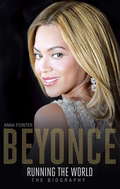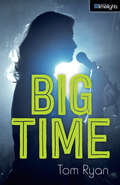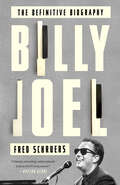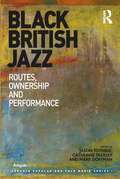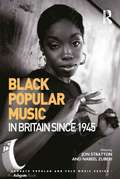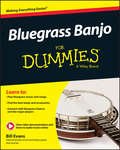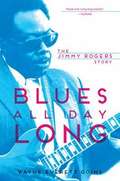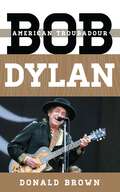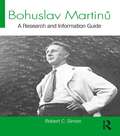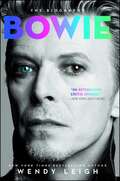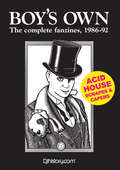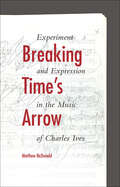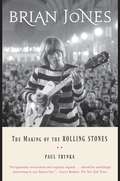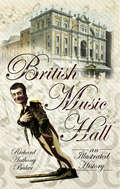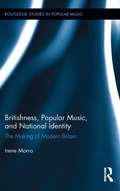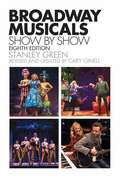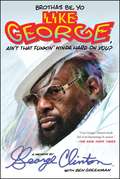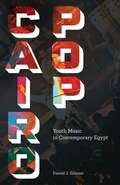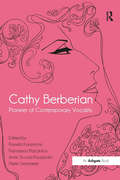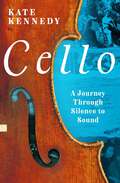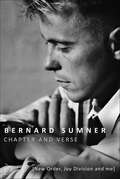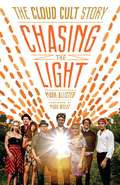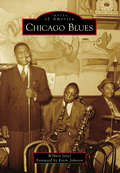- Table View
- List View
Beyoncé: Running the World
by Anna PointerAs a painfully shy six-year-old singing in her parents' kitchen back in the late eighties, it was impossible to imagine the meteoric rise that Beyoncé Knowles would go on to achieve. Fast forward 25 years and not only has she sold 75 million albums, making her one of the most successful recording artists of all time, but she is also an actress, fashion icon, producer and doting mother. <p><p> Beyoncé: Running The World is the full story of Houston born-and-bred Beyoncé's extraordinary life, which saw her join her first pop group at the age of nine before fronting the girl band Destiny's Child - the biggest-selling female group of all time. After embarking on a solo career in 2003, Beyoncé's status as a superstar was sealed and to date she has won more than 220 awards internationally and the hearts of millions of fans the world over. As the world's biggest star, Beyoncé continues to scale new heights and her latest album, Beyoncé, broke all records after hitting No.1 in more than 100 countries. Echoing the sentiment of her 2011 hit single, she really is running the music world right now. <p> The most definitive and up-to-date telling of Beyoncé's story ever written, this book provides an intimate close-up on both her professional and personal life, with the inside story on how she and rapper husband Jay-Z became the biggest power couple on earth. With reports that their marriage was crumbling before the world's eyes on their 2014 joint tour, On The Run, it pieces together the split rumours that plagued them at every turn and documents exactly how they coped with such intense public scrutiny. The book also analyses Beyoncé's role as a mother to young daughter Blue Ivy and explores the hidden heartbreaks of her past, including a tragic miscarriage, a lengthy battle with depression and an agonising rift with her manager father Mathew. <p> While celebrating Beyoncé's greatest triumphs Beyoncé: Running The World uncovers the truth behind the headlines, finding out exactly who 'Queen Bey' is and what really goes on behind the scenes...
Beyoncé: The Biography
by Anna Pointer'Everything you ever wanted to know about the world's biggest singing star.' 5* - BestBeyoncé: Running The World is the full story of Houston born-and-bred Beyoncé's extraordinary life, which saw her join her first pop group at the age of nine before fronting the girl band Destiny's Child - the biggest-selling female group of all time. After embarking on a solo career in 2003, Beyoncé's status as a superstar was sealed and to date she has won more than 220 awards internationally and the hearts of millions of fans the world over. The most definitive and up-to-date telling of Beyoncé's story ever written, this book provides an intimate close-up on both her professional and personal life, with the inside story on how she and rapper husband Jay-Z became the biggest power couple on earth. With reports that their marriage was crumbling before the world's eyes on their 2014 joint tour, On The Run, it pieces together the split rumours that plagued them at every turn and documents exactly how they coped with such intense public scrutiny.The book also analyses Beyoncé's role as a mother to young daughter Blue Ivy and explores the hidden heartbreaks of her past, including a tragic miscarriage, a lengthy battle with depression and an agonising rift with her manager father Mathew.While celebrating Beyoncé's greatest triumphs Beyoncé: Running The World uncovers the truth behind the headlines, finding out exactly who 'Queen Bey' is and what really goes on behind the scenes...Contains an extra chapter with the most up-to-date information on the world's biggest star.
Big Time (Orca Limelights)
by Tom RyanGerri waits outside all night to audition for Big Time, her favorite TV singing competition. She believes she has a shot at success, but when she’s insulted by one of the judges and kicked out of the competition, she thinks she’ll probably never sing again. After a teacher at her school asks her to join a choral club, Gerri reluctantly gets involved. Even though she can’t read music and she doesn’t know the other kids, she finds herself enjoying the group and learning a lot about music. A cute guy she met at the Big Time auditions joins the group, and when they perform their unique mashups at an open-mic night, Gerri realizes there’s more than one way to be a successful—and happy—singer! This short novel is a high-interest, low-reading level book for middle-grade readers who are building reading skills, want a quick read or say they don’t like to read!
Billy Joel: The Definitive Biography
by Fred SchruersThe long-awaited, all-access biography of a music legendIn Billy Joel, acclaimed music journalist Fred Schruers draws upon more than one hundred hours of exclusive interviews with Joel to present an unprecedented look at the life, career, and legacy of the pint-sized kid from Long Island who became a rock icon.Exhibiting unparalleled intimate knowledge, Schruers chronicles Joel's rise to the top of the charts, from his working-class origins in Levittown and early days spent in boxing rings and sweaty clubs to his monumental success in the seventies and eighties. He also explores Joel's creative transformation in the nineties, his dream performance with Paul McCartney at Shea Stadium in 2008, and beyond.Along the way, Schruers reveals the stories behind all the key events and relationships--including Joel's high-profile marriages and legal battles--that defined his path to stardom and inspired his signature songs, such as "Piano Man," "Scenes from an Italian Restaurant," "New York State of Mind," and "She's Always a Woman." Throughout, he captures the spirit of a restless artist determined to break through by sharing, in his deeply personal lyrics, the dreams and heartbreaks of suburban American life.Comprehensive, vibrantly written, and filled with Joel's memories and reflections--as well as those of the family, friends, and band members who have formed his inner circle, including Christie Brinkley, Alexa Ray Joel, Jon Small, and Steve Cohen--this is the definitive account of a beloved rock star's epic American journey.
Black British Jazz: Routes, Ownership and Performance (Ashgate Popular and Folk Music Series)
by Jason Toynbee Catherine TackleyBlack British musicians have been making jazz since around 1920 when the genre first arrived in Britain. This groundbreaking book reveals their hidden history and major contribution to the development of jazz in the UK. More than this, though, the chapters show the importance of black British jazz in terms of musical hybridity and the cultural significance of race. Decades before Steel Pulse, Soul II Soul, or Dizzee Rascal pushed their way into the mainstream, black British musicians were playing jazz in venues up and down the country from dance halls to tiny clubs. In an important sense, then, black British jazz demonstrates the crucial importance of musical migration in the musical history of the nation, and the links between popular and avant-garde forms. But the volume also provides a case study in how music of the African diaspora reverberates around the world, beyond the shores of the USA - the engine-house of global black music. As such it will engage scholars of music and cultural studies not only in Britain, but across the world.
Black Popular Music in Britain Since 1945 (Ashgate Popular and Folk Music Series)
by Jon Stratton Nabeel ZuberiBlack Popular Music in Britain Since 1945 provides the first broad scholarly discussion of this music since 1990. The book critically examines key moments in the history of black British popular music from 1940s jazz to 1970s soul and reggae, 1990s Jungle and the sounds of Dubstep and Grime that have echoed through the 2000s. While the book offers a history it also discusses the ways black musics in Britain have intersected with the politics of race and class, multiculturalism, gender and sexuality, and debates about media and technology. Contributors examine the impact of the local, the ways that black music in Birmingham, Bristol, Liverpool, Manchester and London evolved differently and how black popular music in Britain has always developed in complex interaction with the dominant British popular music tradition. This tradition has its own histories located in folk music, music hall and a constant engagement, since the nineteenth century, with American popular music, itself a dynamic mixing of African-American, Latin American and other musics. The ideas that run through various chapters form connecting narratives that challenge dominant understandings of black popular music in Britain and will be essential reading for those interested in Popular Music Studies, Black British Studies and Cultural Studies.
Bluegrass Banjo For Dummies
by Bill EvansStart picking the five-string banjo like a pro with this definitive guide to bluegrass banjo! Whether you re an absolute beginner or an experienced player, Bluegrass Banjo For Dummies gets you started off the right way and is your road map for mastering today s most popular traditional and contemporary banjo picking styles. Online audio and video clips combine with the book s clear step-by-step instructions to provide the most complete and fun - banjo instruction experience available anywhere! Bluegrass banjo has never been more popular and is heard today not only in country and folk music, but in jazz, rock and country styles. Bluegrass Banjo For Dummies provides everything you need to know to play just about any kind of music on the five-string banjo by getting you started with the roll patterns essential to Scruggs style picking. You ll then add left-hand techniques such as slides, hammer-ons and pull-offs, play great sounding licks and perform classic tunes like Cripple Creek and Old Joe Clark. You ll navigate up the neck on the instrument as well as learn the essential skills you need to play with others in jam sessions and in bands. You ll even tackle contemporary banjo styles using melodic and single-string scales and picking techniques. Choose a banjo and accessories that are just right for you and your budget. Put on your fingerpicks, find your optimal hand position and start playing with the help of online audio and video. Explore the fingerboard using melodic and single-string playing styles. Accompany others in different keys with roll patterns and chord vamping techniques. Keep your banjo sounding its best with practical and easy set up tips. Bill Evans is one of the world s most popular banjo players and teachers, with over forty years of professional experience. In Bluegrass Banjo For Dummies, he shares the tips, secrets and shortcuts that have helped thousands of musicians, including many of today s top young professionals, to become great banjo players.
Blues All Day Long: The Jimmy Rogers Story (Music in American Life)
by Wayne Everett Goins Kim WilsonA member of Muddy Waters' legendary late 1940s-1950s band, Jimmy Rogers pioneered a blues guitar style that made him one of the most revered sidemen of all time. Rogers also had a significant if star-crossed career as a singer and solo artist for Chess Records, releasing the classic singles "That's All Right" and "Walking By Myself." In Blues All Day Long, Wayne Everett Goins mines seventy-five hours of interviews with Rogers' family, collaborators, and peers to follow a life spent in the blues. Goins' account takes Rogers from recording Chess classics and barnstorming across the South to a late-in-life renaissance that included new music, entry into the Blues Hall of Fame, and high profile tours with Eric Clapton and the Rolling Stones. Informed and definitive, Blues All Day Long fills a gap in twentieth century music history with the story of one of the blues' eminent figures and one of the genre's seminal bands.
Bob Dylan: American Troubadour (Tempo: A Rowman & Littlefield Music Series on Rock, Pop, and Culture)
by Donald Brown&“The book&’s strength is a thorough assessment of Dylan&’s career, album by album, song by song. Both longtime fans and newcomers . . . will appreciate.&” —Library Journal With Bob Dylan&’s receipt of the Nobel Prize in Literature, his iconic status as an American musical, cultural, and poetic giant has never been more apparent. Bob Dylan: American Troubadour is the first book to look at Dylan&’s career, from his first album to his masterpiece Tempest. Donald Brown provides insightful critical commentary on Dylan&’s prolific body of work, placing Dylan&’s career in the context of its time in order to assess the relationship of Dylan&’s music to contemporary American culture. Each chapter follows the shifting versions of Dylan, from his songs of conscientious social involvement to more personal exploratory songs; from his influential rock albums of the mid-1960s to his adaptations of country music; from his three very different tours in the 1970s to his &“born again&” period as a proselytizer for Christ and his frustrations as a recording and performing artist in the 1980s; from his retrospective importance in the 1990s to the refreshingly vital albums he has been producing in the 21st century. &“This concise examination of the Dylan corpus is especially good for younger generations who may want to better understand how a musician in his early seventies can still be so compelling and relevant in twenty-first-century America.&”. —Booklist &“Fascinating . . . Highly recommended. All readers. —Choice Reviews &“A nearly album by album retrospective of one of the most culturally significant and musically influential musicians in modern history.&” —Examiner &“A must read for Dylan enthusiasts.&” —Journal of American Culture
Bohuslav Martinů: A Research and Information Guide (Routledge Music Bibliographies)
by Robert SimonThis annotated bibliography uncovers the wealth of resources available to prospective researchers and supports emerging scholarship and inquiry into the life and music of this Czech composer. It includes all secondary sources on Martinu and his music, as well as chronology of his life and a complete list of works.
Bowie: The Biography
by Wendy LeighZiggy Stardust, Aladdin Sane, the Thin White Duke. Gender Bender. Rebel. Songwriter. Fashion Icon. Rock God. One of the most influential creative artists of his generation, David Bowie morphed from one glittering incarnation to the next over the course of five decades--an enduring superstar who remained endlessly enigmatic and always ahead of his time. Discover the man behind the myth in this intimate and in-depth biography--featuring a full-color sixteen-page photo insert.David Bowie passed away after an eighteen-month battle with cancer on January 10, 2016. Few knew of his illness, and Bowie flawlessly orchestrated his last goodbye with the release of his final (and some say best) album, Blackstar, featuring the haunting song "Lazarus," and its accompanying video, a farewell message to his millions of fans. Throughout his iconic career that included such hits as "Let's Dance," "Space Oddity," "Heroes," "Modern Love," and "Life on Mars," Bowie managed to retain his Hollywood star mystique. Through in-depth interviews with those who knew him best, New York Times bestselling author Wendy Leigh reveals the man behind Bowie's myriad images--up to and including his role as stay-at-home dad, happily monogamous in his quarter-of-a-century-plus marriage to supermodel Iman. In this "sizzling" (Radar Online) new biography, Leigh brings fresh insights to Bowie's battles with addiction; his insatiable sex life--from self-avowed gay to bisexual to resolutely heterosexual--and countless conquests; his childhood in a working-class London neighborhood and the troubling family influences that fueled his relentless pursuit of success; and much more. This exploration of an artist beloved by so many reveals the man at the center of the mythos.
Boy's Own: The Complete Fanzines 1986-92
by Frank BroughtonThere’s a moment in Jack Kerouac’s 1962 autobiographical come-down novel ‘Big Sur’ where ‘the King of the Beats’ (a term he hated) comes face to face with “some sort of Beat Jesus”, an 18 year old proto-hippy “with a beard and crazy hair”, in San Francisco a good eight or nine years before Woodstock, and a forbearer of a subcultural, generational shift that arguably changed Western culture for good. Boys Own, the Complete Fanzines, 1986-92, has Big Sur moments peppered through the 1986-88 issues, as a small crew of West London football lads, clubbers, music freaks and blaggers start to realise that they’re not just near the centre of Acid House as it starts to emerge from the primordial soup of mid 80’s UK subculture, they and the faces around them are helping create it. Just as Kerouac refused to be dragged into the patchouli scented embrace of the idealistic movement he helped create, by Autumn 1988 the Boys Own central committee were already kicking back against the commercialised explosion in Acid House culture : The TV documentary crews lurking around raves were mocked, the first wave of mass market ravers in Top Shop bought smiley t shirts were famously branded ‘Teds’, the plain clothes coppers in bandanas and day glo laughed at. But whilst Kerouac’s bitterness against the hippies he’d helped create solidified into a destructive, reactionary, booze fuelled hatred, the Boys Own lot carried on throwing parties, dj ing and making records, always ready to have a laugh from the side lines at the assumed self-importance of those same activities. The Boys Own Fanzines, like Oz and International Times for the hippies, or Sniffing Glue and Vague for the punks, remain an invaluable collection of first hand accounts and sharp witted commentaries documenting the pre-history, moment of inception, and after-shocks of Acid House, one of the more exciting and important moments in our modern subcultural history.
Brahms in the Home and the Concert Hall
by Katy Hamilton Natasha LogesJohannes Brahms was a consummate professional musician, a successful pianist, conductor, music director, editor and composer. Yet he also faithfully championed the world of private music-making, creating many works and arrangements for enjoyment in the home by amateurs. This collection explores Brahms's public and private musical identities from various angles: the original works he wrote with amateurs in mind; his approach to creating piano arrangements of not only his own, but also other composers' works; his relationships with his arrangers; the deeper symbolism and lasting legacy of private music-making in his day; and a hitherto unpublished memoir which evokes his Viennese social world. Using Brahms as their focus point, the contributors trace the overlapping worlds of public and private music-making in the nineteenth century, discussing the boundaries between the composer's professional identity and his lifelong engagement with amateur music-making.
Breaking Time's Arrow: Experiment And Expression In The Music Of Charles Ives
by Matthew McdonaldCharles Ives (1874-1954) moved traditional compositional practice in new directions by incorporating modern and innovative techniques with nostalgic borrowings of 19th century American popular music and Protestant hymns. Matthew McDonald argues that the influence of Emerson and Thoreau on Ives's compositional style freed the composer from ordinary ideas of time and chronology, allowing him to recuperate the past as he reached for the musical unknown. McDonald links this concept of the multi-temporal in Ives's works to Transcendentalist understandings of eternity. His approach to Ives opens new avenues for inquiry into the composer's eclectic and complex style.
Brian Jones
by Paul TrynkaFor the first time, the complete story of the enigmatic founder of the Rolling Stones and the early years of the band Brian Jones was the golden boy of the Rolling Stones--the visionary who gave the band its name and its sound. Yet he was a haunted man, and much of his brief time with the band, before his death in 1969 at the infamous age of twenty-seven, was volatile and tragic. Some of the details of how Jones was dethroned are well known, but the full story of his downfall is still largely untold. Brian Jones is a forensic, thrilling account of Jones's life, which for the first time details his pioneering achievements and messy unraveling. With more than 120 new interviews, Trynka offers countless new revelations and sets straight the tall tales that have long marred Jones's legacy. His story is a gripping battle between creativity and ambition, between self-sabotage and betrayal. It's all here: the girlfriends, the drugs, and some of the greatest music of all time. Victors get to write history--but it's rarely fully true. The complete, magnificent story of the Rolling Stones can never be told until we disentangle all the threads and put Brian Jones back in the foreground.
British Music Hall: An Illustrated History
by Richard Anthony Baker'The music hall ...had no place for reticence; it was downright, it shouted, it made noise, it enjoyed itself and made the people enjoy themselves as well.' W.J. MACQUEEN POPEMusic Hall lies at the root of all modern popular entertainment. With stars such as Marie Lloyd, Harry Lauder and Dan Leno, it reached its glorious, brassy height between 1890 and the First World War. In the first book on this subject for many years, Richard Anthony Baker whisks us off on a colourful and nostalgic tour of the rise and fall of British music hall.At the beginning of the nineteenth century people sang traditional songs in taverns for entertainment. This was so popular that rooms started to be added to inns for shows to be staged, and, before long, songs were being specially composed and purpose-built theatres were springing up everywhere. Britain's working class had, for the first time, its own form of public entertainment and its own breed of stars. The colour and vitality attracted serious writers and artists, as well as the future Edward VII, and music hall became simultaneously the haunt of the working classes and the avant-garde.Including stories of a clergyman who wrote music-hall sketches, a hall in Glasgow where luckless entertainers were pulled off stage by a long hooked pole, and Cockney dictionaries that helped Americans understand touring British performers, this book is a hugely engaging slice of social history, rich in humour, tragedy and bathos.As featured on BBC Radio Lincolnshire and in the Sunderland Echo.
Britishness, Popular Music, and National Identity: The Making of Modern Britain (Routledge Studies in Popular Music)
by Irene MorraThis book offers a major exploration of the social and cultural importance of popular music to contemporary celebrations of Britishness. Rather than providing a history of popular music or an itemization of indigenous musical qualities, it exposes the influential cultural and nationalist rhetoric around popular music and the dissemination of that rhetoric in various forms. Since the 1960s, popular music has surpassed literature to become the dominant signifier of modern British culture and identity. This position has been enforced in popular culture, literature, news and music media, political rhetoric -- and in much popular music itself, which has become increasingly self-conscious about the expectation that music both articulate and manifest the inherent values and identity of the modern nation. This study examines the implications of such practices and the various social and cultural values they construct and enforce. It identifies two dominant, conflicting constructions around popular music: music as the voice of an indigenous English ‘folk’, and music as the voice of a re-emergent British Empire. These constructions are not only contradictory but also exclusive, prescribing a social and musical identity for the nation that ignores its greater creative, national, and cultural diversity. This book is the first to offer a comprehensive critique of an extremely powerful discourse in England that today informs dominant formulations of English and British national identity, history, and culture.
Broadway Musicals: Show-By-Show (8th Edition)
by Stanley Green Cary GinellThis book is a selection of shows with historical or other importance to the development of the musical.
Brothas Be, Yo Like George, Ain't That Funkin' Kinda Hard On You?: A Memoir
by George Clinton**ONE OF THE BEST MUSIC BOOKS OF THE YEAR BY ROLLING STONE**The captivating memoir from &“the emperor of intergalactic funk&” (NPR) and most influential pop artists of our time—known for over forty R&B hit singles—George Clinton of Parliament-Funkadelic.George Clinton began his musical career in New Jersey, where his obsession with doo-wop and R&B led to a barbershop quartet—literally, as Clinton and his friends also styled hair in the local shop—the way kids often got their musical start in the &’50s. But how many kids like that ended up playing to tens of thousands of rabid fans alongside a diaper-clad guitarist? How many of them commissioned a spaceship and landed it onstage during concerts? How many put their stamp on four decades of pop music, from the mind-expanding sixties to the hip-hop-dominated nineties and beyond? One of them. That&’s how many. How George Clinton got from barbershop quartet to funk music megastar is a story for the ages. As a high school student, George traveled to New York City, where he absorbed all the trends in pop music, from traditional rhythm and blues to Motown, the Beatles, the Stones, and psychedelic rock, not to mention the formative funk of James Brown and Sly Stone. By the dawn of the seventies, he had emerged as the leader of a wildly creative musical movement composed mainly of two bands—Parliament and Funkadelic. And by the bicentennial, Clinton and his P-Funk empire were dominating the soul charts as well as the pop charts. He was an artistic visionary, visual icon, merry prankster, absurdist philosopher, and savvy businessmen, all rolled into one. He was like no one else in pop music, before or since. Written with wit, humor, and candor, this memoir provides tremendous insight into America&’s music industry as forever changed by Clinton&’s massive talent. This is a story of a beloved global icon who dedicated himself to spreading the gospel of funk music.
Cairo Pop: Youth Music in Contemporary Egypt
by Daniel J. GilmanCairo Pop is the first book to examine the dominant popular music of Egypt, shababiyya. Scorned or ignored by scholars and older Egyptians alike, shababiyya plays incessantly in Cairo, even while Egyptian youth joined in mass protests against their government, which eventually helped oust longtime Egyptian president Hosni Mubarak in early 2011. Living in Cairo at the time of the revolution, Daniel Gilman saw, and more importantly heard, the impact that popular music can have on culture and politics. Here he contributes a richly ethnographic analysis of the relationship between mass-mediated popular music, modernity, and nationalism in the Arab world.Before Cairo Pop, most scholarship on the popular music of Egypt focused on musiqa al-ṭarab. Immensely popular in the 1950s and &’60s and even into the &’70s, musiqa al-ṭarab adheres to Arabic musical theory, with non-Western scales based on tunings of the strings of the &‘ud—the lute that features prominently, nearly ubiquitously, in Arabic music. However, today one in five Egyptians is between the ages of 15 and 24; half the population is under the age of 25. And shababiyya is their music of choice. By speaking informally with dozens of everyday young people in Cairo, Gilman comes to understand shababiyya as more than just a musical genre: sometimes it is for dancing or seduction, other times it propels social activism, at others it is simply sonic junk food.In addition to providing a clear Egyptian musical history as well as a succinct modern political history of the nation, Cairo Pop elevates the aural and visual aesthetic of shababiyya—and its role in the lives of a nation&’s youth.
Cathy Berberian: Pioneer Of Contemporary Vocality
by Pamela Karantonis Francesca Placanica Pieter VerstraeteCathy Berberian (1925-1983) was a vocal performance artist, singer and composer who pioneered a way of composing with the voice in the musical worlds of Europe, North America and beyond. As a modernist muse for many avant-garde composers, Cathy Berberian went on to embody the principles of postmodern thinking in her work, through vocality. She re-defined the limits of composition and challenged theories of the authorship of the musical score. This volume celebrates her unorthodox path through musical landscapes, including her approach to performance practice, gender performativity, vocal pedagogy and the culturally-determined borders of art music, the concert stage, the popular LP and the opera industry of her times. The collection features primary documentation-some published in English for the first time-of Berberian’s engagement with the philosophy of voice, new music, early music, pop, jazz, vocal experimentation and technology that has come to influence the next generation of singers such as Theo Bleckmann, Susan Botti, Joan La Barbara, Rinde Eckert Meredith Monk, Carol Plantamura, Candace Smith and Pamela Z. Hence, this timely anthology marks an end to the long period of silence about Cathy Berberian’s championing of a radical rethinking of the musical past through a reclaiming of the voice as a multifaceted phenomenon. With a Foreword by Susan McClary.
Cello: A Journey Through Silence to Sound
by Kate KennedyA cello has no language, yet it possesses a vocabulary wide enough to tell, bear witness, and make connections across time and continents, which is brought to life in this brilliant new book. In this luminous narrative, Kate Kennedy, a writer and cellist herself, weaves together the story of four cellists who suffered various forms of persecution, injury, and misfortune. The stories are those of the forgotten Jewish cellist Pal Hermann, who is likely to have been murdered by the Nazis in Lithuania during the Holocaust; Lise Cristiani, another forgotten performer, who is considered to be the first female professional cello soloist and who embarked on an epic concert tour of Siberia in the 1850s taking with her a Stradivarius cello that can be seen to this day in a museum in Cremona in northern Italy; Anita Lasker-Wallfisch, who played in the orchestra at Auschwitz and survived spells in both that camp and in Bergen-Belsen; and Amedeo Baldovino of the Trieste piano trio, whose 'Mara' Stradivarius was lost in a shipwreck in the River Plate between Buenos Aires and Uruguay but later recovered from the water and repaired. Interwoven with these remarkable and often moving stories are a series of 'detours' that offer a foil to these remarkable lives. Cello examine the themes explored in the narratives from different perspectives, drawing together historical research, personal experience, and interviews and encounters with contemporary cellists in this unique book that will resonate long after the final page.
Chapter and Verse: New Order, Joy Division and Me
by Bernard SumnerBernard Sumner pioneered the post-punk movement when he broke onto the scene as a founding member of Joy Division, and later as the front man of New Order. Heavily influencing U2 and The Cure while paving the way for post-punk revivalists like Interpol, Sumner's has left an indelible mark on punk and rock music that endures to this day.Famously reluctant to speak out, for the first time Sumner tell his story, a vivid and illuminating account of his childhood in Manchester, the early days of Joy Division, and the bands subsequent critical and popular successes. Sumner recounts Ian Curtis' tragic death on the eve of the band's first American tour, the formation of breakout band New Order, and his own first-hand account of the ecstasy and the agony of the 1970s Manchester music scene.Witty, fascinating and surprisingly moving, Chapter and Verse is an account of insights and spectacular personal revelations, including an appendix containing a complete transcript of a recording made of Ian Curtis experiencing hypnotic regression under the Sumner's amateur guidance and tensions between himself and former band member Peter Hook.
Chasing the Light: The Cloud Cult Story
by Mark Allister&“Cloud Cult&’s grand, unkempt indie rock is at once jam band, emo, and avant-garde. Their songs, born out of personal tragedy, are otherworldly lessons in being human.&” —Pitchfork During the past decade, Minnesota-grown band Cloud Cult has become one of the most inspirational indie bands, with a deeply devoted fan base and an approach to music and the environment that is hard not to admire. Beyond a musical biography, Chasing the Light tells the story of the heartbreaking yet affirming journey of lead singer and songwriter Craig Minowa and delves into the career of the band known by music lovers as the least cynical and most idealistic band in the country.Tracing Cloud Cult&’s rise to critical acclaim, author Mark Allister details the band&’s defining moments, beginning with the death of Craig and Connie Minowa&’s two-year-old son and the hundreds of songs that grew out of the tragic loss. Allister describes the band&’s unique philosophy and principles, including how Minowa created a zero carbon footprint for the band&’s recording and touring, adopting DIY and green-sustainable practices well before the ideas became mainstream. Allister also presents a first-person account of a day in the life of a quintessential indie band and conveys the immense emotional impact of Cloud Cult&’s albums and live shows. Described by a fan in the book as &“the anthem for the soul searcher in us all,&” Cloud Cult&’s music and message are both stirring and sincere.Featuring rarely seen photos from Cloud Cult&’s history and passionate testimonials by fans, Chasing the Light is a testament to the profound influence one band&’s personal evolution can have on its followers and on indie rock aficionados in search of beauty, meaning, and redemption.
Chicago Blues
by Wilbert Jones Kevin JohnsonBlues was once described as the devil's music. It eventually became some of the most beloved American music that was embraced by a global audience. Originating in African American communities in the South in the late 1800s, it was inspired by gospel and spiritual music sung by field hands and sharecroppers who worked on plantations. During the Great Migration from the early 1900s to the mid-1970s, many African Americans moved north for a better quality of life. Chicago was one of America's leading industrialized cites, and manufacturing jobs were plentiful and provided better wages than sharecropping. Many blues musicians who worked as field hands and sharecroppers moved to Chicago not only for those jobs, but also to pursue their love of music. Greats such as Big Bill Broonzy, Tampa Red, Muddy Waters, Jimmy and Estelle Yancey, Robert Nighthawk, Elmore James, Willie Dixon, Earl Hooker, Koko Taylor, Sly Johnson, Buddy Guy, Howlin' Wolf, Eddie Burns, Zora Young, Junior Wells, and a host of others came with their own styles and gave birth to Chicago blues.
